Hunting is portrayed idyllically by those who love it – you can see it here in this beautiful PR shot from the Fish and Wildlife department. The eager young lad and the sage mentor, likely his father or grandfather. The sun rising in all God’s glory. There’s nothing dishonest about any of it. The sunrises do snag your breath and nourish your faith. Quality time between boys and their dads or grandfathers, and increasingly these days dads and their daughters, or hunting moms and their sons or daughters, is huge. But, of course, it’s only part of the story. Life is more complicated than the promotional pictures.
T was bear hunting last Saturday and found one on the top of a mountain in western Vermont. Picture a large-seeming black blob in a sea of beech brush, T trying to ascertain if it was the right bear to take. No hunter wants to shoot a cub. Most hunters don’t want to shoot a sow who’s with cubs. Size can be hard to field-judge. You have a moment to decide. The bear entered a shooting window and T made his choice, the sound of a gunshot ricocheting around the valley.
The bear disappeared over a rise and T ran toward the spot where he’d shot. He found a single drop of blood and no sign in the leaves to indicate struggle. “It wasn’t good blood,” he said, hunter parlance for a poorly placed shot and a difficult tracking job. The protocol in this situation is to give the animal time before you chase it, but he didn’t feel like he had enough information. The ground was bare and the tracking would be difficult so he needed a good line on where the bear was going. You should know, too, that in the back of his mind he was doubting his gun. On his way up the mountain he’d slipped on greasy oak leaves, twisting his knee and slamming the butt of his gun on a stone with enough force to shear the straight-grained walnut. He had wondered if the fall had thrown his scope off but talked himself out of it – the butt had taken the force, not the scope. He remembered this when he saw the single drop of blood. Any feeling of excitement was now tinged with doubt and worry.
He trotted over the rise in the direction the bear had gone and suddenly there were two bears. One of them crashed over a shelf and out of site, the other stood, briefly, and offered a good broadside shot. He rose the gun and then lowered it. He couldn’t tell which bear was which. He didn’t want to accidentally shoot two bears. “Talk about split-second ethical decisions,” he said in retelling the story, the discomfort of it all wrinkled on his brow.
The sinking feeling got worse. Why were there two bears? Why had the bear not run farther? He knelt on the ground and caught his breath. Considered his options. Tried to puzzle things out. Deep down he had a sense of what the answer was.
Needing more information he trotted over to the next rise – the mountain stepped down in shelves. And there was a large bear about 50 yards away, positioned to offer a good shot. Almost simultaneously he saw the two yearling bears halfway up a wolf oak. These were not 40 pound cubs, they were 80 pound yearlings. Bears have young every other year, which means these 1 ½ year olds would soon be on their own. But still, T was among the hunters who, in the soft gaslight of camp where armchair ethics are easy, would never shoot a sow with even yearlings. He has his own little kids, one of whom was back at camp. He wouldn’t bust up a family unit like that.
Back on that mountain, now, where ethics can be hard. The sow was wounded. Potentially gravely, potentially superficially, but how would you know? By the soft light of your computer screen, what’s the right thing to do now?
He made his decision and fired, then fired, then fired again. The sow ran off. The yearlings started down the tree, then stopped, unsure. He backed away and out of sight to let them run down and away. Then he ran to where he’d shot the bear and was given a final opportunity. He shot again and she disappeared. Out of bullets now. He studied the ground for blood and found a few drops, which in the context of the volley of gunfire seemed impossible. There was something clearly off with the gun. His near 70-year-old father and his 5-year-old son were back at camp. He was texting furiously that he needed another gun but getting no reply. He ran-hobbled on the twisted knee three quarters of a mile back to camp. His father had only a .223 with him – a caliber too light, really, for bear; he’d shot a buck opening weekend and was just planning on playing cards with his grandson while his son hunted. There was about two hours of daylight left and a torrential rain storm blowing in. A better gun was a two-hour round-trip away. The .223 was light but better than nothing. They bundled the boy up and went to track the bear.
Here’s another promotional shot we got from Fish and Wildlife. I don’t know if these are real people or models – now that I’m looking closely at it I’d guess they’re real-people models staging a shot. It’s nice, isn’t it? And it’s not all that different from the family phalanx in this story, except this kid was five years old and not carrying a weapon, and this father was gimpy on a swollen, hurt-maybe-worse-than-he-thought knee, and this old man wasn’t smiling like that, he was straining. They weren’t walking on a logging road; they were climbing up ledges that were vertical enough in places that you had to use your hands and arms. The little one looked confused. And the middle-aged one looked worried. And the older one looked out of breath. T thought: my old man’s going to have a heart attack.
It took a long time to get back to where they wanted to be. Too long, really. When they arrived they had about an hour of light and used it circling, circling, looking for tracks, or blood, some indication of what had happened. They found nothing. They circled up and over the top of the mountain and searched until their eyes strained, then strained some more against the light of their headlamps. The five year old was done. He was crying and wanted to go home. T thought: I’m going to ruin hunting for this kid. They gave up and headed back to camp, hobbled and walked over the ridge and down, down into dark woods that felt increasingly unfamiliar. T had no compass, and his cell phone, which recently showed a 40 percent charge and which had a stupid digital compass on it, was now showing 0 percent battery and that little plug icon. He murmured words unspeakable in front of the five year old.
You couldn’t make this up, right?
“Dad, we’re going the wrong way.” “No we’re not.” There was a test of wills before T pointed to a tree stump. “Look,” he said. “No hinge. It’s a feller-buncher.” His father knew the logging history of the parcel they hunted and it had only been cut with chainsaws. On the backside of the wrong ridge now, with no compass, on an ink-black night, on a star-shaped mountain, the wind howling and a significant storm blowing in. His son is crying and somewhere in this Nightland is a sow that was wounded by his hand. It’s not fear he feels at this fact, it’s regret. And more than that, he’s aware that he’s sharing with her some small sliver of cold, red-in-tooth reality. He’s feeling his heart beat in his swollen knee and that sow is feeling her heart beat in what, with luck, will turn out to be a superficial wound. They’re sharing that fierce primal instinct to protect their children. They’re feeling that barometer drop, each with their own vision of what’s coming next.
We were editing a piece on hunting recently, and the author was saying that meat and management were his primary motivations, and as we were poking the story, as editors do, one editor commented that it felt empty without a nod to the recreational aspect; that it felt too clinical. Most hunters I know, she said, say the motivation is getting out there in the fields and woods in the cold early morning, watching the sun come up, the thrill of game approaching.
Like the picture at the top of this story, you know?
But there’s a big difference between why people hunt and why they kill, which is something you’d better have a firm grasp on before you pull the trigger. One thing PETA is absolutely right about is that you don’t need to carry a gun to get up early and watch the sun rise or to spend time with your dad. The why-we-kill part of hunting is endlessly interesting to me because it’s not pleasant, and the vast majority of the millions of human hunters around the world are decent, empathetic people. Because we are different than animal predators in that we understand the consequences of our actions beyond a next meal, we construct these elaborate moral codes through which we practice the craft, and eventually, because of the very tenuous nature of the pursuit, we’ll all be put in positions that challenge what we thought we knew about ourselves. It’s these challenges, it’s this assumption of responsibility inherent to hunts that sometimes end terribly, that makes hunting so deep and complex. Put yourself in T’s head as he lie awake that night, pondering missteps, searching for truths and meanings, trying to make peace with what had transpired. Some go through these kinds of stories and never want to hunt again, and others go through them and will never be able to not hunt again. It’s why big game hunting borders on religion in many rural areas – it has that same depth. No serious hunter will find it surprising that before Abrahamic gods humans worshiped animal gods; that the hunt was organized religion.
T fired the last ethical bullet he had in his chamber the next morning, when his father asked if he was going out bear hunting. “No,” he said, and made sure his son heard. “I wounded a bear and never recovered it. My tag was filled the second I saw a drop of blood.”
It was a deft shot.




Discussion *